47: Animal Nutrition/Digestive
1/62
There's no tags or description
Looks like no tags are added yet.
Name | Mastery | Learn | Test | Matching | Spaced |
|---|
No study sessions yet.
63 Terms
ingestion
the feeding method used to take food into digestive cavity
digestion
splitting of carbs, proteins, lipids, and nucleic acids into foods into chemical subunits to be absorbed
absorption
movement of organic molecules, electrolytes, vitamins, and h2o across digestive epithelium and into the IF of digestive tract
1 calorie
- amount of energy required to raise the temp of 1g pure water by 1 C
- 1Kcal = 1000 calories = 1 Calorie
malnutrition
- deficiencies, excesses, or imbalances in a person's intake of energy and/or nutrients
- types: undernutrition, micronutrient-related, overnutrition
undernutrition
- insufficient intake of energy and nutrients to meet and individuals needs to maintain good health
- socioecon. and geopolitical factors
- wasting : low weight for height
- stunting : low height for age
- underweight : low weight for age
micronutrient-related malnutrition
micronutrient deficiencies (lack of vitamins/minerals) or micronutrient excess
overnutrition
overweight, obesity, and diet-related noncommunicable diseases (ie stroke, diabetes)
animals can make ___________ BUT they can NOT make _______________ and ____________ , which they must get from their _____________
1. many organic molecules
2. essential amino acids
3. essential fatty acids
4. diet
vitamins
- organic molecules required in small quantities
- humans need 13
- water soluble vs fat soluble
- excess water soluble vitamins are excreted in urine
- excess fat soluble vitamins are stored in adipose tissue
- only vit. D can be synthesized in body, rest come from food
- many are coenzymes
vitamin D synthesis
- response to uv radiation on the skin -> photochemical cleavage of 7-dehydrocholestorol -> formation of vitamin D
- vit. D enters the circulation -> bound to vit. D-binding protein (synthesized in liver) -> hydroxylated in the liver
-> 2nd hydroxylation in kidney to now be calcitriol
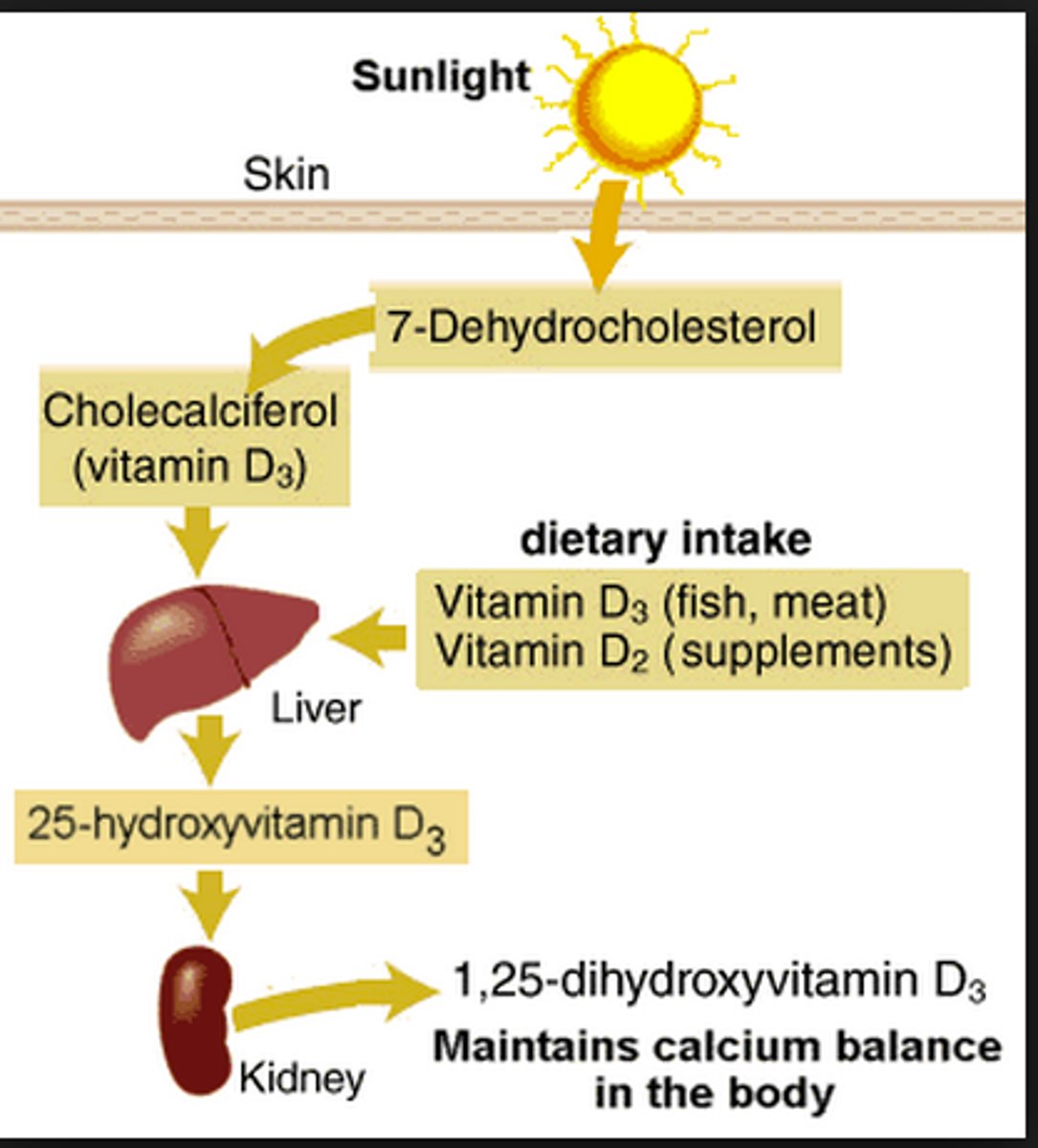
vitamin K
- required for blood-clotting factors in the liver
- humans cannot be make vitamin K, but is mostly supplied by bacterial activity in large intestine
fluid feeders
- ingest liquids that contain organic molecules in solution
- ex mosquitoes and hummingbirds
suspension feeders
- ingest small organisms that are suspended in water
- ex clams and baleen whales
deposit feeders
- ingest particles of organic matter from solid material they live in or on
- ex earthworms and crabs
bulk feeders
- consume sizeable food items whole or in large chunks
- ex adult mammals, reptiles, birds, and amphibians
enzymatic hydrolysis
- breakdown of chemical bonds by the addition of H+ and OH-
- amylases : hydrolyze starch
- lipases : hydrolyze fats and other lipids
- proteases : hydrolyze proteins
- nucleases : hydrolyze nucleic acids
intracellular digestion
- sponges
- take in food particles by endocytosis via pores in body wall
- food particles fuse w/lysosome (hydrolytic enzymes) -> breakdown
- the subunits pass form vesicle to the cytosol
- undigested material is released via exocytosis
- choanocytes : aka collar cells; line the body wall ; trap food particles and take them in and transport them
Sac-like digestive system
- flatworms and cnidarians
- single opening (mouth and anus) for entrance and exit of food and waste
- lake separate vascular system -> water taken in from gastrovascular cavity circulates through the various tissue layers
- begins in gastrovascular cavity but is completed intracelluarly
extracellular digestion
- most invertebrates and all vertebrates
- digestion is outside body cells, and happens in a pouch or tube that is enclosed w/in body
- specialized compartments to prevent digestion of self
- epithelial cells secrete digestive enzymes
- greatly expands the range of available food sources and ability to eat large batches of food
digestive tubes
- two openings
- contents move in one direction from mouth (proximal and anterior) to the anus (distal)
- lumen (inside) : functionally external to all body tissues -> opens to external environ.
- specialized regions for each steps
steps of digestion
1. mastication : mechanical breakdown -> incr. mobility and SA; chewing/grinding/tearing
2. secretion of enzymes : release of enzymes and other substances to aid in the process; ex acids, emulsifies, lubricating mucus
3. enzyme hydrolysis : food further broke down via enzyme reactions
4. absorption : molecular subunits are absorbed from digestive contents into body fluids and cells
5. elimination : undigested materials are expelled via anus
annelid (earthworm) digestion
- deposit feeder
- muscular activity to move particles from esophagus to crop (cavity for storage and mucus)
- mixture enters the gizzard (grains of sand) -> ground into particles
- mixture enters long intestine to be (1) hydrolyzed, (2) moves along via muscle contractions, and (3) absorbed via lining
- undigested expelled via anus
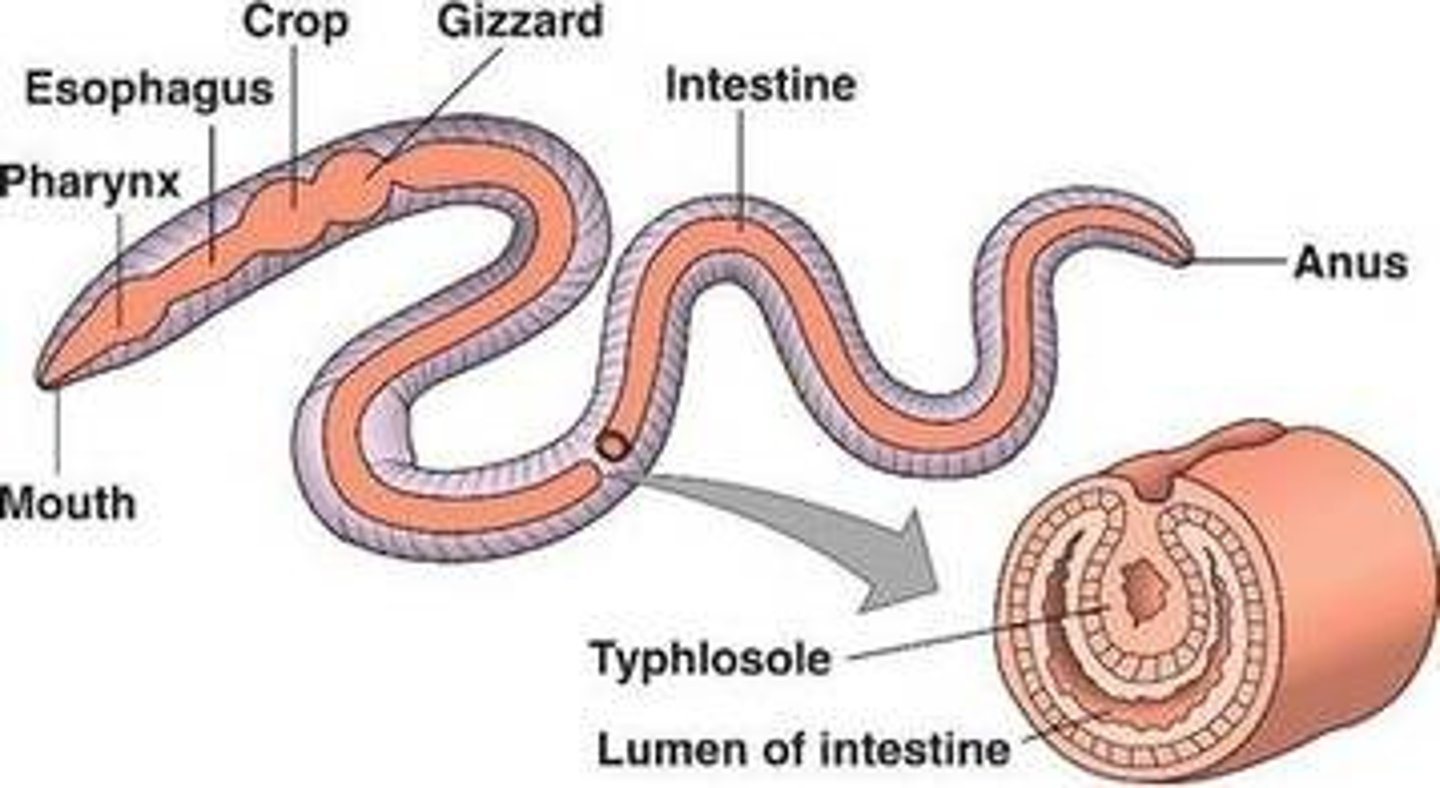
insect (grasshopper) digestion
- tear plants into small particles via mouth parts
- pharynx contains salivary enzymes
- pharynx -> esophagus -> crop -> gizzard -> stomach -> intestine -> anus
- stomach contains enzymes for hydrolysis
bird digestion
- seeds swallowed whole -> moistened by mucus-filled saliva -> goes to pharynx -> esophagus -> crop (stores food) -> proventriculus (enzyme breakdown) -> gizzard (seeds ground up) -> intestines, liver, pancreas (more enzymes) -> anus
human/mammal digestion
- series of specialized digestive regions under nervous and endocrine control
- muscular tube
- primary : mouth, pharynx, esophagus, stomach, small and large intestines, rectum, anus
- secondary : salivary glands, teeth, tongue, pancreas, liver, gallbladder
- specific digestive variations per animal
digestive organs
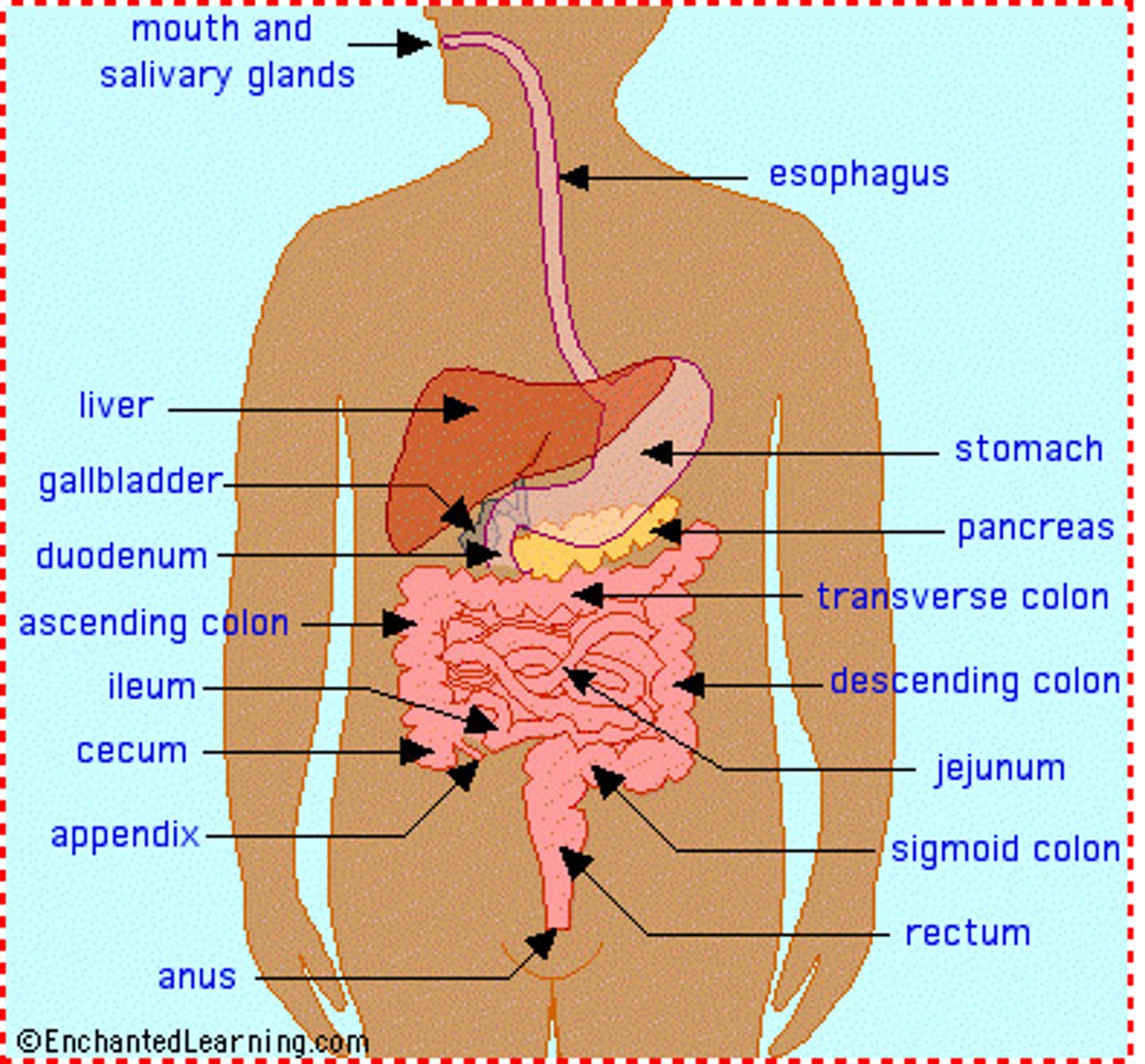
essential amino acids
- lysine, tryptophan, phenylalanine, threonine, valine, methionine, leucine, isoleucine, and histidine (for children)
- found in proteins of fish, meat, egg whites, milk, and cheese or a combination of certain plants
essential fatty acids
- linoLEIC acid and linoLENIC acid
- required for the synthesis of phospholipids and hormones
- almost all food contain
- deficient -> risk of coronary heart disease
minerals
- macrominerals : required in large amounts (>100mg); calcium, phosphorus, magnesium, sodium, potassium, chloride, and sulfur
- trace minerals : required for small amounts (<1mg); iron, manganese, copper, iodine, zinc, cobalt, fluoride, and selenium
- all minerals are ingests as compound/ion in solution
- too much Na+ -> elevated bp
- too much iron -> damage to liver, heart, pancreas, and blood vessels
layers of the gut
- mucosa : layer facing the open space (lumen) of the tube; contain epithelial, glandular cells; lines the inside -> mucous epithelium, lamina propria, muscularias mucosae
- epithelial cells : absorbed nutrients; seal off the digestive contents from body fluids
- glandular cells : secrete enzymes, lubricating mucus, and helps with pH
- submucosa : thick layer of elastic connective tissue w/neuron networks (enteric nervous sys), blood and lymph vessels, and small glands
-muscularis : formed by circular and longitudinal layer; for mechanical processing and movement along; peristalsis (wave of contraction)
- serosa : outermost layer; made of serous membrane; visceral layer of the peritoneum; connective tissue and peritoneum (attach and cover the walls) layers
sphincter muscles
- forms valves bt major regions -> control the passage of digestive contents
- pharyngoesphageal sphincter : upper esophageal sphincter
- gastroesophageal sphincter : lower esophageal
- pyloric sphincter
- ileocecal sphincter
gastroesophageal reflux disease (GERD)
- backward flow of stomach acid into the esophagus
- symptoms : burning and pressure behind the breastbone
- treatments : OTC antacids or acid-blocking meds, avoiding certain foods, losing weight, stop smoking
- untreated -> Barrett esophagus (changes inn esophageal lining)
flow of food through digestive tract
1. mouth/oral cavity
2. pharynx and esophagus
3. stomach
4. small intestine
5. large intestine
6. expelled out the anus
components of saliva
amylase (hydrolyze starch), mucus, bicarbonate ions, and lysozymes (kill bacteria)
functions of oral cavity
- forms food into a bolus to be swallowed
- sensory analysis of food before swallowing
- mechanical digestion
- lubrications by mixing mucus and saliva
- limited chemical digestion of carbs and lipids
pharynx and esophagus functions
- swallowing reflex to move the bolus down
- epiglottis : prevents food from entering the trachea
- peristalsis in esophagus moves the bolus to the gastroesophageal sphincter
- imperfect closure due to weak gastroesophageal sphincter
stomach
- large distensible sac, muscular elastic organ -> largest diameter -> expands while eating
- layers : outer longitudinal, middle circular, inner oblique layer
- rugae : prominent folds when relaxed and not expanded
- storage of ingested food
- mechanical and chemical breakdown of foods
- production of intrinsic factor -> glycoprotein for B12 absorption in small intestine
- food becomes a viscous, highly acidic, soupy mixture that is partially digested -> CHYME
- PERISTALIC contractions of stomach wall to move chyme through PYLORIC sphincter into small intestine
gastric mucosa (stomach lining)
- mucosal layer (epithelium) -> covered w/gastric pits that contain gastric glands
- stretch receptors simulate secretion of gastric juice (pepsinogen, HCL, mucus)
- chief (zymogenic) cells -> pepsinogen; near base of gastric gland
- parietal cells -> H+ and Cl- and intrinsic factor -> decr. pH for pepsin activity and unfolds proteins to be digested
- mucous (goblet) cells -> secrete alkaline mucus -> protect lining from acid
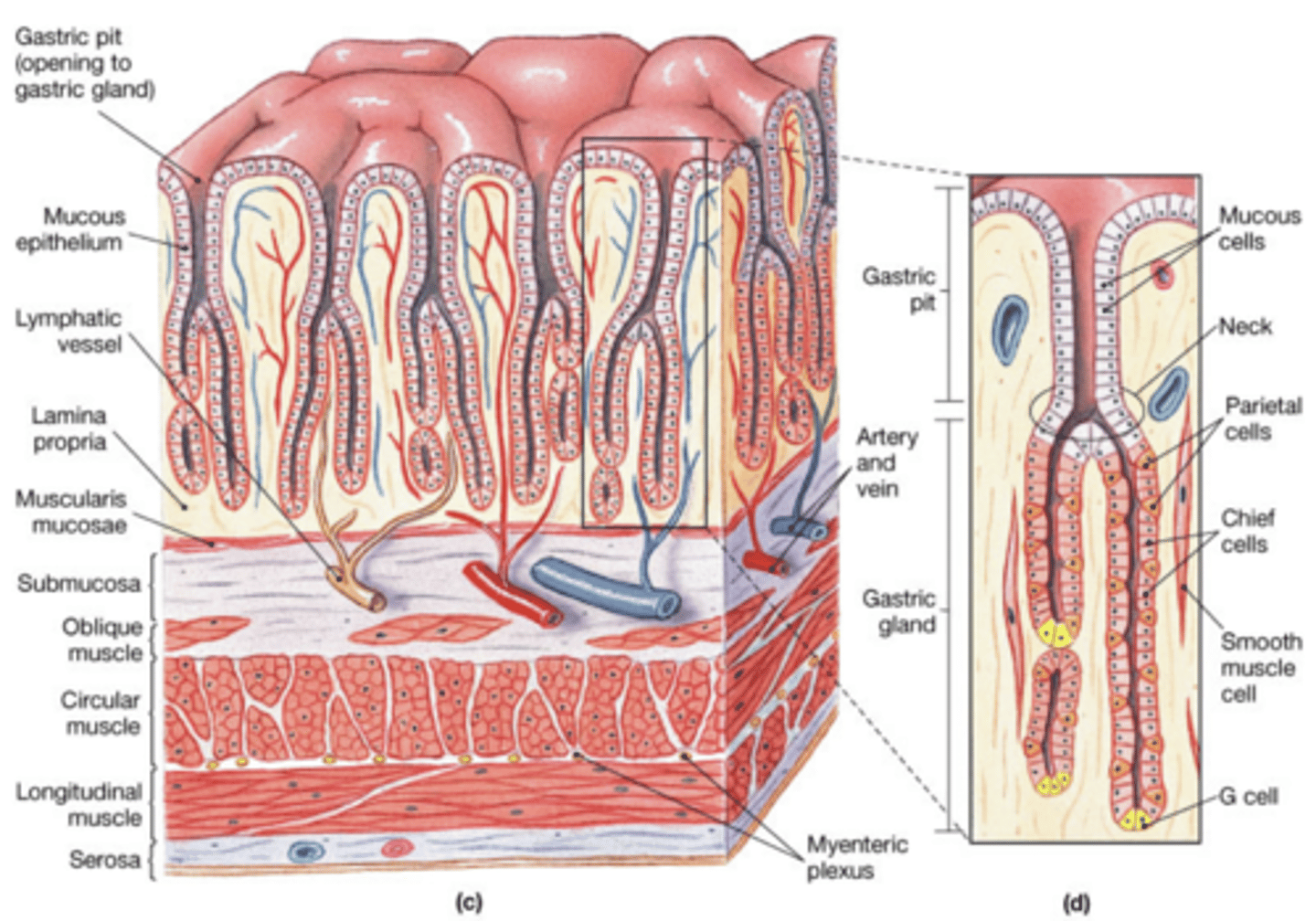
small intestine
- begins at pyloric sphincter of the stomach and extends to the cecum
- where most absorption begins and digestion is completed
- ridges that are covered by intestinal villi
- epithelial cells covering the villi have a brush border of microvilli
- micro/villi and folds -> increase absorption SA; always present
- pancreas provides digestive enzymes and buffers to neutralize chyme -> LIPASE
- liver secretes bile (stored in gallbladder) -> buffer and bile salts
- duodenum : "mixing bowl"; recieves chyme from stomach and digestive secretions from pancreas and liver
- jejunum : bulk of chemical digestion and nutrient absorption
- ileum : final and longest segment
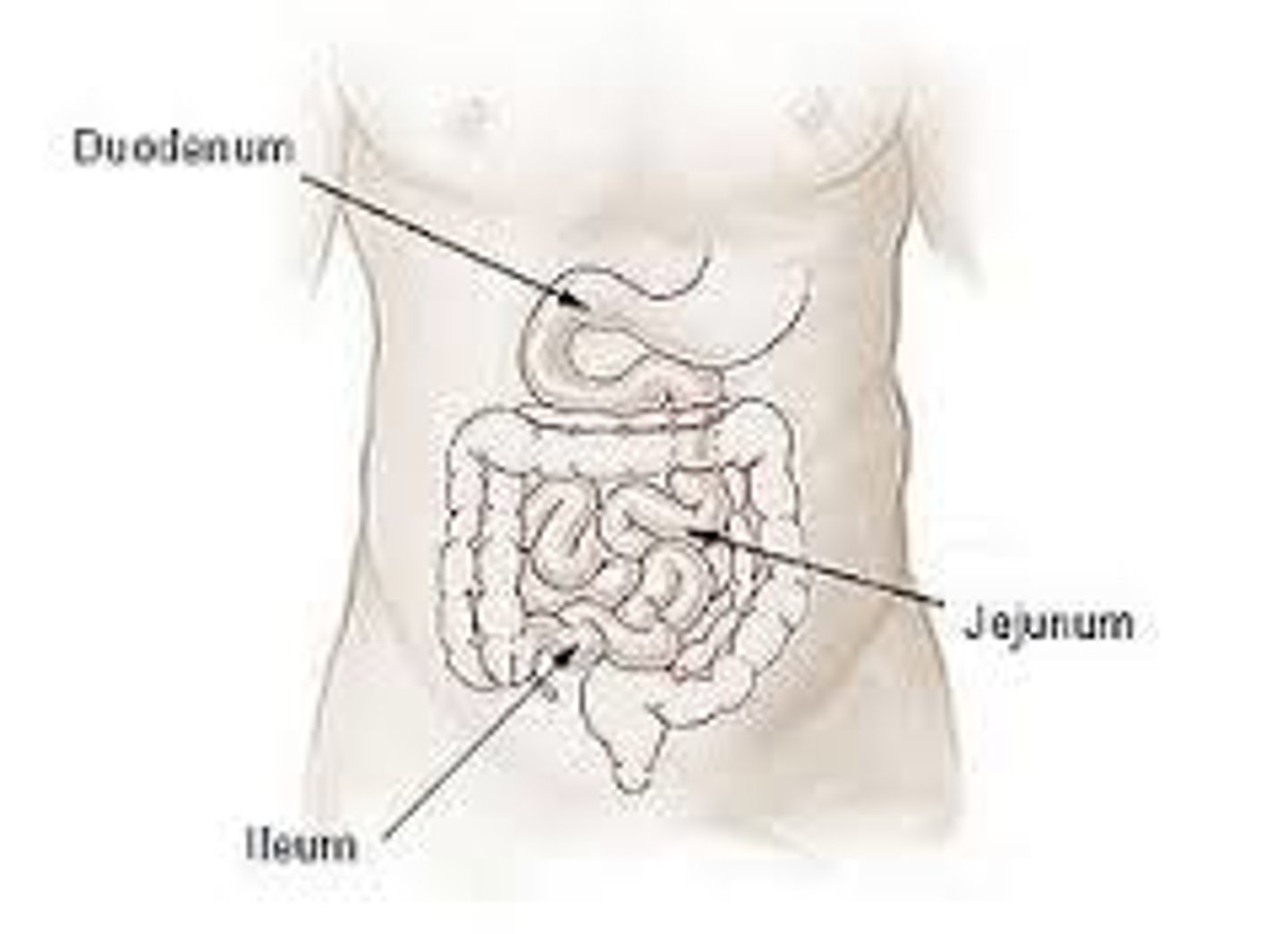
liver
- secretes bicarbonate ions and bile
- bile : mixture of substances including bile salts, cholesterol, and bilirubin
- bile salts -> form hydrophilic coating around fats -> allows them to be emulsified
- bilirubin -> gives bile the color; waste product derived from worn-out red blood cells
- nutrient molecules absorbed in small intestines travel to the liver via HEPTATIC PORTAL VEIN
- excess glucose units combine to form glycogen -> stored in liver -> for when bs drops
- synthesize lipoproteins
- detoxifies ethyl alcohol and other toxins
- inactive steroid hormones and other drugs
enzymes in small intestine to complete digestion
- disaccharidases : break maltose, lactose, and sucrose into individual monosaccharides
- aminopeptidases : hydrolyze small peptides to individual amino acids
- nucleotidases : break nucleic acids into nucleosides
- nucleosidases : convert nucleosides into nitrogenous bases, 5 carbon sugars, and phosphates
enzymatic digestion of nutrients
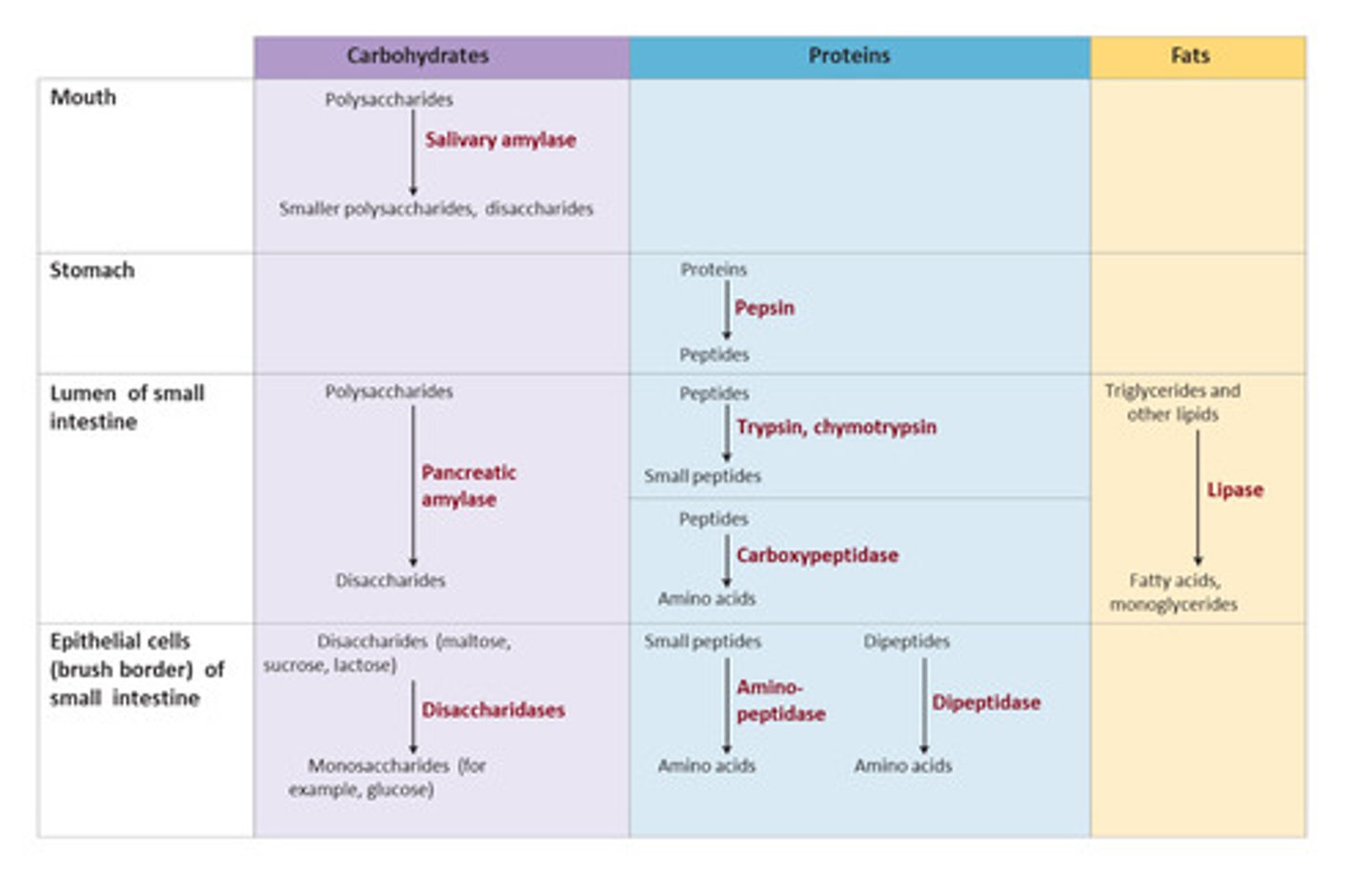
absorption of water soluble nutrients
- enter the intestinal mucosa cells by ACTIVE TRANSPORT or FACILITATED DIFFUSION -> water follows by osmosis
- nutrients are transported from the mucosal cells into ECF and enter the bloodstream in the capillary networks of the submucosa
lactose intolerance
- lactose is broken down into glucose and galactose by lactase
- inability to synthesize lactase -> affects absorption of lactose -> broken down by bacteria -> produce excess methane and CO2 -> distends the intestine -> pain
- treatment : lactase tablets
chylomicrons
- small droplets covered by a protein coat
- secreted into IF of the submucosa and taken into lymphatic sys.
- fatty acids and monoglycerides are combined into triglycerides and packaged
large intestine
- begins at end of ileum and ends at anus
- cecum : pouch like; 1st portion; collects and stores materials from the ileum and begins the process of compaction
- colon : largest portion; ascending, transverse, descending, and sigmoid sections
- rectum : last 15cm and end of digestive tract; terminated at anal sphincter -> expandable for storage of feces -> movement triggers defecation
- <10% of nutrient absorption
- prepares fecal material for defecation
- inner surface -> smooth and NO VILLI
- ileocecal valve : controls passage bt small to large intestine
- secretes mucus, bicarb ions
- reabsorb water and other ions (Na+, Cl-, bile salts and vitamins) -> process of compaction into solid

vermiform appendix
- extends from the cecum
bacteria in large intestine
- 30-50% in feces
- metabolize sugar, produce useful fatty acids, and vitamins
- convert bilirubin into urobilinogen and stercobilinogen -> further converted to urobilin and stercobilin when exposed to O2 -> gives yellow-brown color
- urobilinogen -> absorbed into circulation and excreted in urine
- also breakdown peptides that remain -> generate ammonia, indole and skatole, and H2S
- bacteria activity produce large quantities of gas (CO2, methane, H2S) -> either absorbed via intestinal mucosa or expelled (flatulence)
defecation reflex
- feces enter the rectum -> stretch rectal wall -> opens the anal sphincter and expel feces through the anus
regulation of digestion and food intake
- interaction of the automatic nervous sys.
- local neuron networks in the gut wall (enteric NS)
- endocrine glands
- digestion speeds up or slow down to produce max. efficiency in the breakdown of food molecules and absorption of nutrients
controls in the digestive tract
- The presence of food in the mouth activates receptors that increase the rate of salivary secretion
- Stretch receptors in stomach walls set off signals that increase the rate and strength of stomach contractions
- Chemoreceptors in the stomach respond to food molecules, particularly proteins, with secretion of the hormone GASTRIN
- Circulating gastrin returns to the stomach, where it stimulates secretion of HCl and pepsinogens, and stomach contractions
duodenum hormones
- acidic chyme in duodenum stimulates glandular cells to release SECRETIN -> inhibits gastric emptying to prevent more acid entering, acid production in stomach, stimulates HCO3- secretion to neutralize the acid
- fat and protein stimulate secretion of CHOLECYSTOKININ (CCK) -> inhibits gastric activity and stimulates secretion of pancreatic enzymes, allows time for nutrients in the duodenum to be digested and absorbed
- GLUCOSE-DEPENDENT INSULINOTROPIC PEPTIDE (GIP) -> stimulates the pancreas to release insult -> stimulates uptake and storage of glucose
hypothalamus
- integrates the number of signals involved in regulation of food intake
- leptin and insulin are important for long-term regulation of energy balance
- ghrelin and peptide YY are important for short term regulation of energy balance
leptin
- aka satiety hormone
- secreted by adipocytes
- fat stores increase -> more leptin is secreted
- acts on hypothalamus in neg. feedback mechanism to suppress appetite -> decreasing food intake and triggering weight loss
- reduce appetite and inhibits the center that simulates appetite
- binds to body cells -> fatty-acid oxidation
- decr. fat storage -> leptin decr. and incr. of appetite-stimulating hormones
- encoded by ob gene -> nonfunctional gene or no response to receptors -> obesity
insulin
- secreted by pancreas when level of glucose, fatty acids and amino acids incr. after meal
- on hypothalamus -> suppress food intake
ghrelin
- acts on hypothalamus to stimulate appetite
- opposes the activity of leptin and insulin
peptide YY
- acts on hypothalamus to signal satiety
- opposite mechanism to ghrelin
common specialization in vertebrates
- tooth modification
- structure and function of esophagus, stomach, and cecum, and length of digestive tract
- nutrient rich food -> short intestine
- herbivores -> long intestinal tract -> extract more nutrients from plant matter
- variation of types of enzymes secreted
teeth
- reflects diet, feeding method, habitat, and lifestyle
- specialization is evident in mammals
- incisors : front of mouth; flattened and chisel-shaped; to rip, nip, or cut food
- canines : pointed at the sides of incisors; long and sharp; for biting and piercing
- premolars and molars : sides of mouth; to crush, shear, and grind
- omnivores will have all types developed
microbiomes
- complete collections of microorganism associated w/particular organism
- consist mostly of bacteria, but other unicellular organism are present
- gut microbiomes : in digestive tract; important for digestion
symbiotic microorganism
- herbivores use microorganism that synthesize cellulase to breakdown plant material
- other animals have mutualistic microorganism that synthesize essential amino acids/vitamins to help w/digestion
ruminants
- cattle, deer, goats, sheep, and antelopes
- complexed 4-chambered stomach
- boluses of plant matter go to rumen and reticulum -> where symbiotic microorganisms are housed -> fermentation rxn to hydrolyze cellulose
- fermentation rxn generate nutrients and methane gas
- regurgitates material from rumen and reticulum to then be rechews and re-swallowed -> now moves to gastric stomach to be chemically broken down and kill the microorganisms
- dead microorganism -> rich source of protein/nutrients